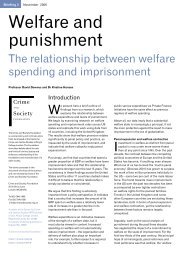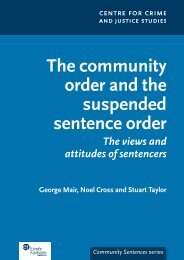PRISON SERVICE
PRISON SERVICE
PRISON SERVICE
- No tags were found...
You also want an ePaper? Increase the reach of your titles
YUMPU automatically turns print PDFs into web optimized ePapers that Google loves.
There are various outlets for theses images tocirculate and become fixed in the popular imagination.Among them is the reporting of crime by themainstream TV news programmes, the various genericcrime series on our TV and in realty TV programmessuch as Police, Camera, Action. And of course themainstream Hollywood film. In these visual regimes ofcrime and punishment the working classes areassociated with crime and imprisonment is seen as thesolution to the social and economic ills that arethreatening to overrun our society.These media representations of the working classcompliment other discursive constructions of theworking classes acrossmultivariate strands of publicdiscourse so for instance we canfind examples of the denigrationof working class culture and theblaming of working class peoplefor the problems that beset theirlives in the speeches ofpoliticians, the pronouncementsof educationalists and thesentencing policies of thejudiciary. The conditioningprocess of repetitivereinforcement across a range ofsites results in an acceptance ofthe working classes as morecriminally inclined while denyingthe transgressions of white-collarmiddle class crime.It is the right to selfrepresentationthat Inside Filmattempts to provide — the rightof the prisoners to represent theirown lives and not to beconsigned to a secondarycharacter in dominant narratives that situate them asthe obstacle to a better, safer society. In representingthemselves and their own experiences the studentscome face to face with the reality of their own lives.Not in the sense that they suddenly have access to howdreadful their lives are — they are already fully aware ofthis and awareness will not alter the fact of theirposition in the hierarchal structures of a class riddensociety. What I lay claim to here is the possibility of theconsideration of their lives as part of a wider totality.The pedagogical practices of Inside Film emphasises theimportance of placing dominant representations in thewider context of the economic system in which theyexist, insisting on the relationship between economicsand culture. This dialectical analysis allows for anThe prisonpopulation stands atabout 86,000 Morethan three quartersof prisoners cannotread or write to thestandard expectedof an 11-year-oldchild, half of allprisoners do nothave the skillsrequired by 96 percent of jobs.exploration of popular culture as just one aspect ofdominant political, economic and ideologicalhegemonic practices and refuses to countenance itsdetachment as ‘just entertainment’.In 2005 the basic skills agency assessmentrecorded the results of a literacy survey amongprisoners in England and Wales. They reported 60 percent of the prison population had a reading abilityequivalent to or less than a five-year-old child. Theprison population stands at about 86,000 More thanthree quarters of prisoners cannot read or write to thestandard expected of an 11-year-old child, half of allprisoners do not have the skills required by 96 per centof jobs. Only one in five people inprison are able to complete a jobapplication form. 15These figures are notdefinitive — reports of literacylevels fluctuate but it is generallyaccepted that two thirds of theprison population cannot read toa standard that enable them tounderstand what is going onaround them. These figuressuggest that the provision ofeducational courses designed todevelop literacy skills or whichentail reading and writing beyonda certain level of achievement canonly reach a very limited numberof people — the minority of theprison population that hasalready achieved acceptablelevels of literacy skills. This meansthat by definition courses centredon reading and writing mustexclude the majority of prisonerswho cannot write and these arearguably those who are the hardest to reach. Thisexclusion will only repeat a pattern that for manypeople serving sentences in prison has become thenorm.The association of writing with school lessons alsoraises another problem. I have already pointed out theexperience of school for most of the people in prisonhas been an alienating one. Enzensberger claimed that‘intimidation through the written word has remained awide spread and class specific phenomenon even inadvanced industrial countries.’ This is because mostpeople learn to write in the formalised setting of schoolin an authoritarian environment where good writing isbased upon inviolable rules that result in penalisation ifthey are broken. 1615. James, E.http://www.guardian.co.uk/society/joepublic/2009/sep/17/erwin-james-education-prisoners-rehabilitation (accessed 09.02.09)16. Enzensberger, H. (1982) Critical Essays: London: Continum p.71.Issue 192 Prison Service Journal19











